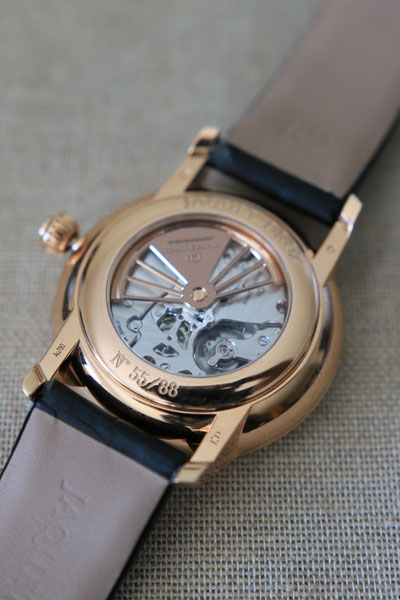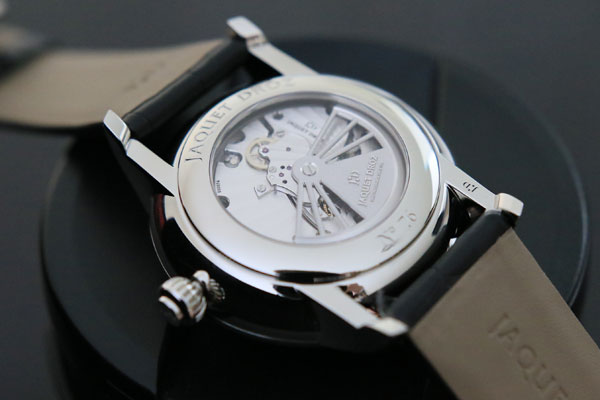Thanks to the folks at Jaquet Droz I was recently lucky enough to spend some time with not just one, but three out of four of the brand’s Grande Seconde Deadbeat models. As if I’m not bombarded with watchmaking information enough during the week, this model had caught my eye in the window of the Tourbillon store in Lausanne on one Saturday afternoon, because of the way the central deadbeat seconds hand glides around the dial. Some consider the complication to be a little ironic, since it involves reducing the frequency of the seconds hand’s movement from around five jumps per second (in the case of an 18,000 vibrations per hour movement) to just one, which makes its movement look similar to that of a quartz watch. I say only “similar” because for me at least, the effect is not the same. There is no harsh “tick” at every movement of the hand, since the power is still coming from a mechanical movement operating at a normal [[frequency]]. Furthermore, the movement of the hand itself is not the same as a quartz watch: it glides around the dial elegantly, rather than jumping abruptly, even though this type of complication is also referred to as a jumping seconds.

The deadbeat escapement was invented by mathematician and astronomer Richard Towneley and first used in astronomical clocks produced by Thomas Tompion that were installed at the Greenwich Observatory on 7 July 1676. Another English watchmaker, George Graham, adapted the escapement to pocket watches and it subsequently found its way into wristwatches. Jaquet Droz brings this type of [[escapement]] up to the state of the art by using a silicon [[balance]] spring and a 10-toothed cam for the deadbeat seconds, rather than the 30-toothed cams used by other brands. The second hand also takes pride of place at the centre of the watch, as it does in all the “Grande Seconde” models, with other timekeeping functions found on off-centred subsidiary dials.
The Grande Seconde Deadbeat collection comes in three very different guises. The red-gold versions with a choice of black or white dials in grand feu [[enamel]], offer the most classical interpretation, while the stainless-steel version with a black onyx dial has a more understated look. The hour and minute dial at 12 o’clock has a polished 18-carat white-gold ring surrounding it, but there are no numerals and the “numerus clausus” text has also been removed from the minute track. The only numerals visible on the dial are for the date. The most everyday piece is undoubtedly the stainless-steel version with the silvered opaline dial. The blued-steel hands contrast perfectly against this background and details such as the transition from Roman numerals to Arabic numerals at 5, 6 and 7 o’clock blend in harmoniously with the retrograde date dial that completes the figure of eight found in most Jaquet Droz timepieces.

Visible beneath a transparent sapphire crystal exhibition case back is the Jaquet Droz 2695SMR calibre. A [[self-winding]] movement (thanks to a heavy-metal [[oscillating weight]]) with a power reserve of 38 hours, it fits snugly in the 43mm diameter case, which is water resistant to 30 metres. A black alligator leather strap with folding clasp completes the ensemble.






